Artist of the Month: Gerard Brender à Brandis
Nestled just off Stratford’s main square is an artist’s cottage. It is a muted yellow with deep chocolate accents; a white portico with columns entices you in off the street. Enter through the small English cottage garden, past a sign that shows that, indeed, this is an artist’s cottage.

It is the home and studio of Canadian artist Gerard Brender à Brandis, a wood engraver, painter, poet, and one of the most interesting people I’ve ever met. While we were exploring (and loving) Stratford, Visit Stratford suggested that we visit with Gerard. Little did I know that it would not only be our favorite time in Stratford, but a highlight of my year.

Gerard is an old-world gentleman, full of knowledge, kindness, manners, humor, and a calming, warm presence that welcomes you into his genteel, beautiful space.

It starts with the house, a Greek revival saltbox built in 1866 and lovingly restored, and the garden, running rampant with greens and purples and overflowing with creativity. The exuberance of the garden is paired with the serenity of the interior, for this house is perfectly set up for an artist to work and exhibit in. You’re greeted by Smudge, an aptly-named companion for a wood engraver and printer, and by Gerard himself, with smiles and a warm welcome.
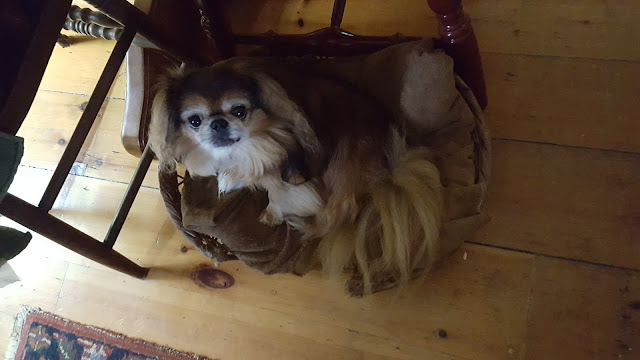

Enter the parlour and delve into Gerard’s lifetime of work, from a plethora of binders overflowing with single prints to framed works on the wall to handmade books. The subjects are wide – native and garden flowers (orchids are a favorite), Shakespeare’s musical instruments, birds and wildlife, and, of course, nature. I could spend hours here, both talking with Gerard, and marveling at his work. In the winter, he spins and weaves in this room, for he also creates the covers for his limited edition handmade books.

But it is the studio across the hall that is the true home of the artist. The room is lined with bookshelves and cabinets, holding supplies. There is a wide table in the middle of the room, precisely set with pencils, watercolors, and the print that Gerard is hand-coloring at the moment. I could stare at this table forever, wishing myself, like Arietty or the Borrowers, into the spaces of this peaceful, purposeful cottage.

The heart of the room is a small desk, set at the window, lined with burins to carve with and a sand-filled leather pad upon which he rests his woodblock. The natural light streaming through the window is yet another indicator that here, although we’re inside, nature is important to Gerard – for not only does he draw and carve nature into reflection, but he does it in natural light, with minute lines and details that reflect an intense awareness of detail and form. And, as Gerard mentions, a woodblock is the opposite of what you will see – so he draws his subject, then draws it in reverse, and then carves that reverse drawing so that it will print into what you see.







Like a king’s throne, the Albion press, imported from England, towers over the room, imposing its lines and purpose into the air. Gerard tells of visiting England, and looking for such a press – and luckily, finding an extra from a printer with many! Unobtrusively resting at the side of the room is a tri-fold rack, clothespins holding recent prints to dry. Both are equally important aspects of the printing process.

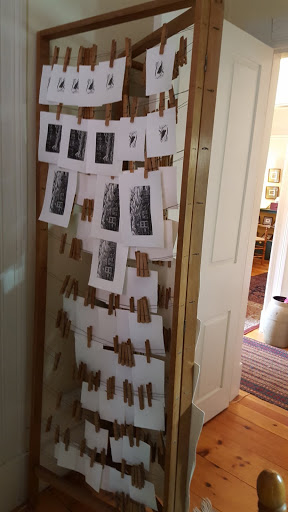
Gerard’s life as an artist is filled with details, intricacy, and a kindness and peace so enveloping that the world is a better place from his art. He spreads joy and awareness of the natural world though his carvings, passion, and purpose.
While we were there, we talked much about the creative process, and how Gerard works closely with his sister, the writer Marianne Brandis (here's her lovely interview on living a creative life as a writer). It is truly a remarkable thing, the works of art and literature these two create together – a collaboration and process I’ve never seen before. In Devil’s Artisan: A Journal of the Printing Arts, Number 64, she writes of the artist at work, and examines his life as an artist.
“That art – for all its apparent restraint, and the discipline imposed by the limitations of the medium – is a celebration of what is: a delight in what he sees, and a depiction of it that evokes its essential nature. Getting beneath the ‘colour’ of the visible world (as is required by his working mainly in black and white) enables Gerard to show the shapes of things, the relationship of forms to each other, and the patterns they make. He celebrates the whole (and the wholeness) of what he sees – and the ‘beyond’ that it points to – by paying loving and at the same time analytical attention to the specific…Gerard’s work is slow and painstaking. An engraving or a book grows organically, the result of a complex fusion of craft and art, experience and vision.”
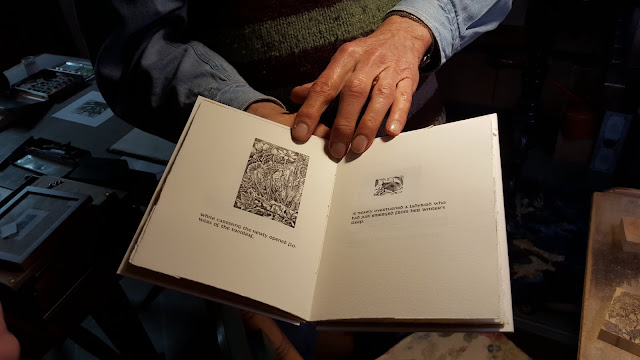
Here, in his own words and images, Gerard Brender à Brandis:
How long have you been an artist?
I started my art career as soon as I had graduated from McMaster University in Hamilton, Ontario, with a B.A. in Fine Arts History in 1965, although I had had a two-person exhibition the previous year.
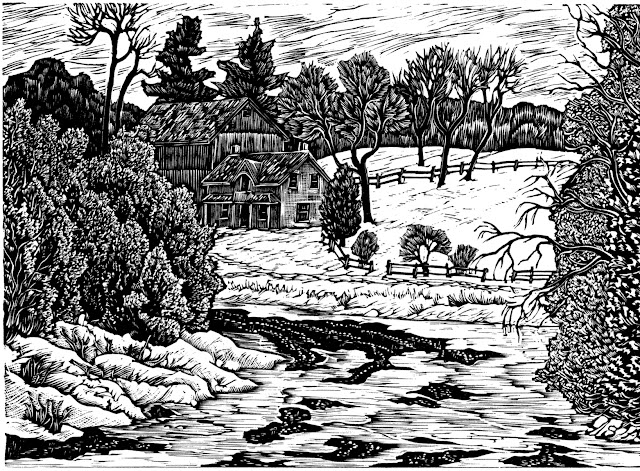
End of Winter on the Upper Grand River
Is your art your full-time career?
In the early years I did some part-time teaching to make ends meet, and during the last twenty-four, since my move to Stratford, I have spent a considerable amount of time talking with visitors to my studio during the summer months (which makes me a part-time artist and part-time shopkeeper for six months of the year), so I cannot claim to be a full-time artist.
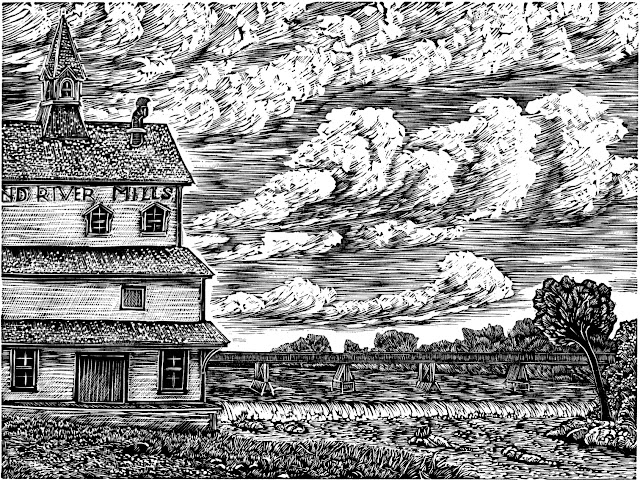
Grand River Mills, Caledonia
Where do you work? How long have you been there?
I work mostly in my studio (the original dining room of my heritage home in Stratford where I have lived for ten years) but also do many of my sketches on the spot (I do not use a camera) which means going to the subject if it is a landscape or something in a pioneer village or a plant in a public botanical garden or private greenhouse. For my book on all the flowers mentioned by Shakespeare, I travelled to England to draw plants and some of the locations associated with Shakespeare, such as his birthplace, the houses where his mother and wife grew up, and the house where his daughter lived after her marriage, etc. I have done similar trips to Newfoundland, Cape Cod, and places in eastern and western Canada.

The Hermitage, Cayuga
What materials do you prefer?
My favourite medium is wood engraving, using very sharp, tiny chisels called burins to engrave blocks of boxwood that can be printed on my 1882 Albion printing press. For each of these, I do a pencil sketch followed by a detailed pencil drawing before drawing the design in reverse in ink on the wooden block. But I also love making very detailed watercolour paintings of plants in my garden or of the potted orchids I grow in my home, and, occasionally, I like to revel in the much freer and spontaneous medium of an oil painting.

The Grand River at Byng Island
Do you work on one or more pieces at a time?
I often work on several pieces at a time. This could include the kind described above or include things like binding the books I print with my blocks and old foundry type, or sometimes spin flax into thread which I dye with vegetable dyes and weave into linen covers for my handmade editions.
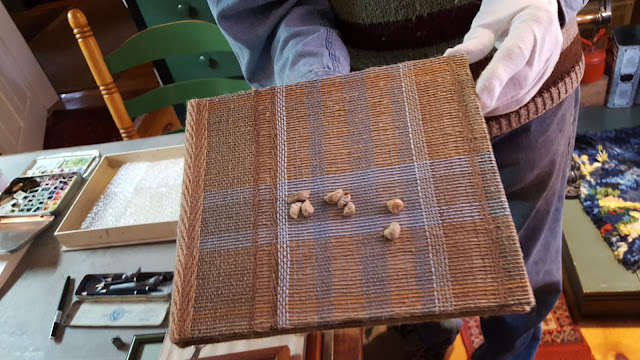
If you were not a painter/sculptor/photographer, etc. what would you do?
If I were not a painter/printmaker/bookwright, I would want to be a gardener.

Green Dragon
How do you know when your piece is done?
I know when a piece is done when a tiny click occurs in my brain that says that doing anything more would ruin it all. But sometimes that click is wrong, and a few days, months, or even years later, I jump in and do more with it, occasionally with disastrous results.

The Junction of the Ninth and Grand Rivers at Paris
How can our readers find and purchase your art?
People can best see my work by coming to my studio or to one of the three little galleries in Canada that sell some pieces for me. The best thing for them to do would be to visit my website for more information: https://www.gerardbrenderabrandis.ca/
Wood engraving photos from The Grand River, art by Gerard Brender à Brandis, written with Marianne Brandis, published by The Porcupine's Quill:
In the images and words of two artists, The Grand River explores the river’s history, beginning with its formation after the end of the last Ice Age. The book gives insight into the private life of a river—the dialogue of land and water—as well as the ways in which a river interacts with humans, vegetation, wildlife, weather and the planet. It takes the reader on an imaginary journey from the Grand’s first drop of moving water at the source to the point where it flows into Lake Erie.
“As well as being about the river’s biography in space and time, this book is about how two artists perceive the river and have come to understand its importance to the part of the planet that it flows through. In images and words we reflect on "riverness", the private life of rivers, the dialogue between land and water, the connections with vegetation and climate and weather, with humans and their works.
The story of the river and the watershed is a human story, a very Canadian one about First Peoples, exploration and immigration, immigrants and what they brought and created here.
This river—here—is everywhere.” ~ Marianne Brandis
To learn more: http://porcupinesquill.ca/bookinfo6.php?index=304
Wood engraving photos courtesy and copyright Gerard Brender à Brandis; all other photos courtesy and copyright Wandering Educators




















